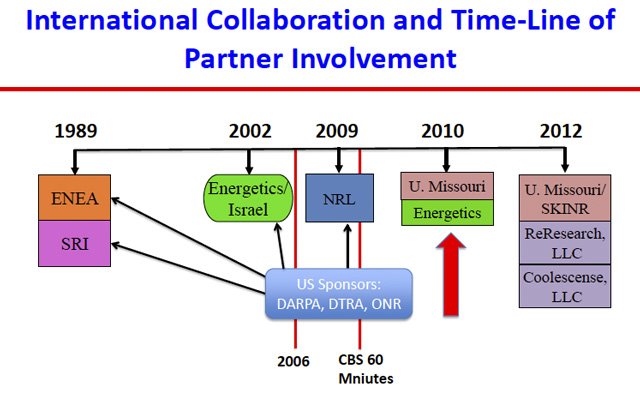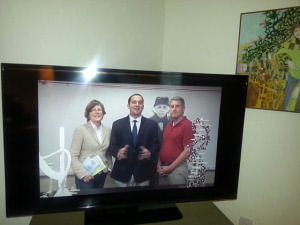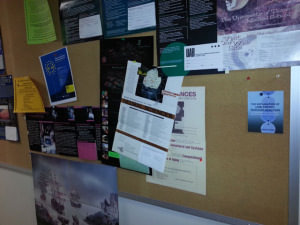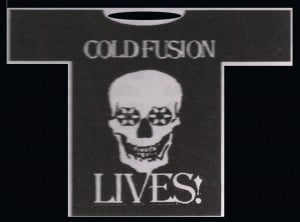Title graphic: Cold Fusion Then – Cold Fusion Now!.
It was twenty-six years ago today that the world learned of a new form of energy that promised a green technological future for all life on Earth.
Twenty-six years later, we can’t yet buy a reactor in Home Depot, but prototypes are multiplying in independent labs.
We don’t yet have university labs training a new generation of scientists, but young entrepreneurs are self-organizing around open-science principles.
The ground is formed, and a figure emerging. A critical mass of awareness has occurred.
Could a man like Bill Gates ignore what he was told one day last fall?
And where would the most powerful man in the world go to get the real deal on the scientific question of our time?
The Department of Energy? Oh do not be cruel.

Watch Graham Hubler’s SKINR Overview from ICCF-18.

Now Dr. Duncan is at Texas Tech University as Senior Vice President for Research, where he is Founder and Director for the Center for Emerging Energy Sciences (CEES). From the Texas Tech University Board of Regents Agenda Book for the meeting December 11-12, 2014 [.pdf], CEES will study the Anomalous Heat Effect (AHE), one of the many names for cold fusion that emphasizes the mysterious and as-yet-unknown reaction that creates fusion-sized heat from small, table-top reactors.
According to Texas Tech, total research expenditures topped $140 million in 2012. What portion will go to CEES? Even 1% would be a welcome change, but not enough to do what CEES wants: to discover the nature of the reaction, and engineer a technology.
 They will partner with ENEA, the Italian National Agency for New Technologies, Energy and Sustainable Economic Development and contract with a scientist “soon to retire” from SRI International. These two institutions are experienced in the field of condensed matter nuclear science, publishing major results over twenty-six years of research.
They will partner with ENEA, the Italian National Agency for New Technologies, Energy and Sustainable Economic Development and contract with a scientist “soon to retire” from SRI International. These two institutions are experienced in the field of condensed matter nuclear science, publishing major results over twenty-six years of research.

The complete service environment for a new energy technology is now in place. We have the metal, we have the water, and we have a desperately broken global economy ready for re-tooling.
Alliances are forming. How will the LENR community respond?
Cold fusion scientists, so used to being ignored, now expect to be ignored. They are as ill-prepared today for the onslaught of attention as Drs. Martin Fleischmann and Stanley Pons were twenty-six years ago when the two quiet researchers emerged from their basement lab to tell what they had found, and were crushed by the satellite environment invading their every beaker.
Since then, the International Society for Condensed Matter Nuclear Science should have had CNN covering their conferences, but most of the time, they had NO ONE. When someone was there, it wasn’t Anderson Cooper, it was Infinite Energy Magazine, and sometimes, those scalawags from Cold Fusion Now.
When the Gates Foundation does makes their move (and how could they not?), will the second tier of capitalists start jumping in? Will CNBC start sending professional crews for sit-downs with real video equipment – and lights?! You betcha!
And where will the press go to for clear information? How do you start to investigate a story that has been hiding in plain sight for two-and-a-half-decades?
Well, er, I am available as of this morning to design and manage any public relations campaign, so please do call.
What will you get?
Hmmm…
UPDATE on Cold Fusion Now Actions
I have little time to blog anymore.
The poor Cold Fusion Now website is neglected and in disarray. (Wanna help re-design? Email me!)
My activity hasn’t stopped…
Last fall, I was on our local TV news surreptitiously holding two cold fusion books, Developments in Electrochemistry Science Inspired by Martin Fleischmann and The Explanation of Low Energy Nuclear Reaction, as I talked about the upcoming Science Night at our community college.
More recently, our little town’s tribute to Leonard Nimoy, simply called Spock Day, brought the news cameras out, and they caught a little promo I always bring with me. Notice the Cold Fusion Now sticker in the corner?! How about the new Hydrogen coasters on the bar? Check out these photos snapped off the TV:




All lots of fun, but is it really making a difference?
YES!
While cartoons of hydrogen atoms, and running around leaving coasters on bars may seem like a joke to the serious-minded, (and I’ve gotten the “disgruntled” mail to prove it!) I believe that every act of advocacy is worthwhile, and has the potential to change one life, or a billion lives.
Any moment, a teaching moment!
In a recent algebra class, I was demonstrating properties of polynomial functions. I brought up Making Sense of Alumina Spectral Emissivity, a new paper by Bob Higgins on his deep-dive into the thermal imaging of the nickel-hydrogen “dog-bone” reactors. It is an excellent introductory article to the sticky issues in thermal measurement. In the paper is the equation for radiant power emitted from a blackbody as proportional to the temperature of the body to the fourth power, M = εσ T4.
As I started to talk about how coefficients scale a function, and in particular how the emissivity effects the radiant power in this equation, several students brought up Andrea Rossi and the E-Cat – more than ever before! I was able to answer some questions, putting people on the path to reason, instead of reaction. Who knows what that will be inspired in the minds of creative youth?

Even more fun was the trip to San Diego this past January to interview Navy scientists on their work in cold fusion research.
Altogether, I filmed a total of five hours video interviews with Dr. Stanislaw Szpak, Dr. Frank Gordon, both from the SPAWAR lab, and Dr. Melvin Miles, from the China Lake Research lab. I have finished editing a first movie from those interviews, and I’ve already started on a second.
It’s important to have these scientists who’ve worked so long alone to tell their own story. Cold fusion has a complicated history, with a complicated science, and complicated people. As it moves to the mainstream, and information begins to dissipate through the feeds, a need for simplicity will distort the truth of the real events as they happened.
If the people who lived it don’t tell their story, someone else will. The LENR community must shape the story of what happened when one of the greatest discoveries of all time was kept from the world. It is important for the integrity of those who suffered the consequences; the intrepid researchers must be recognized, and the rest of us deserve a clean-energy future.
Hep the elite to what’s going down!

Walking into Dr. Gray’s office, he was open to meeting us, and surprised at the activity in the LENR field. He remarked, “I’ve got a lot of catching up to do.”

Rocket scientists always get the latest

I left a serious wad of materials on the way down to San Diego (I asked permission, and the gal said “Oh yeah, we’re always happy to have more stuff to look at”), and when I came back through a week later, they were all gone, so I laid more down.
The Cold Fusion Now calendar magnet was still on the soda machine. Yah!

Got a ticket for the ride of your life?
We have only to look back at the early publications of Infinite Energy Magazine, started by Eugene Mallove and Jed Rothwell, to see what lies ahead: an explosion of interest, and businesses popping up like clover. I get dizzy thinking about the speed at which this nascent technology will sweep the planet – and I can’t wait!
For twenty-six years, the world has been moments away from breakthrough. We don’t have to wait much longer. We will have a second chance at designing living arrangements for all the life on our planet – and we can begin now!
All in all, the lack of activity on the Cold Fusion Now website is only because we are taking our activism to a new level. I do want to sincerely apologize to everyone I have not written back this past year. Your messages are important to me, and give me a boost when I really need it. I thank you and am grateful for your support. With two p-t jobs and a mortgage, I haven’t been able to respond in a timely manner. I will do better.
There is much more activity going on, but it’s still premature to tell the details.
Like, did I ever tell you about the time …
..Aiy yai yai!









